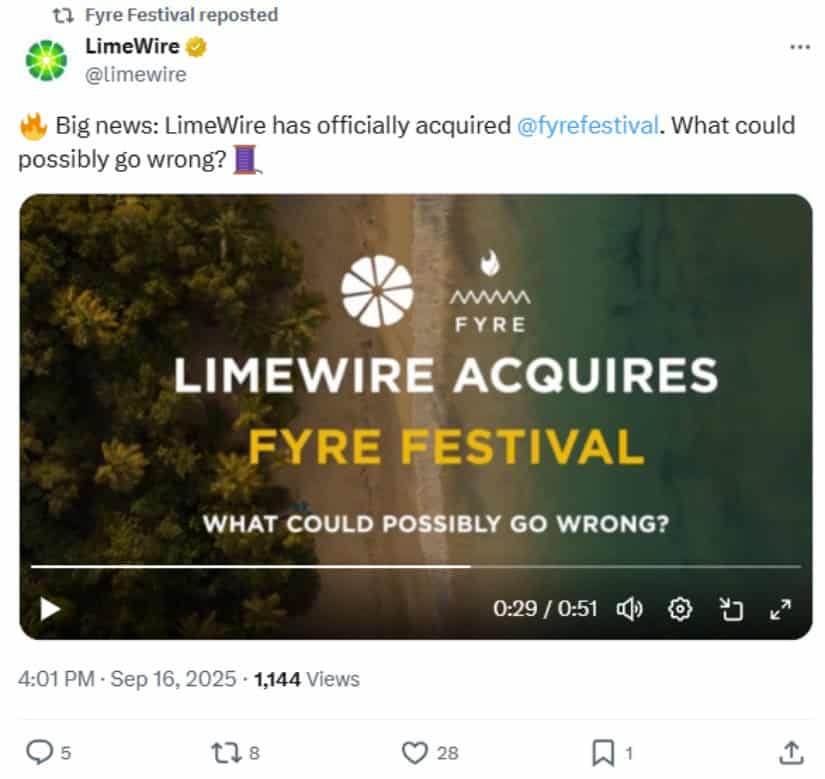Like a weary traveler stumbling upon a forgotten battlefield, the world awoke to the news-LimeWire, that relic of digital rebellion, had claimed the carcass of Fyre Festival. The announcement, delivered with the solemnity of a court jester, arrived via social media. “Big news: LimeWire has officially acquired @fyrefestival,” they declared, as if purchasing a sinking ship with a wink and a promise of better navigation. “What could possibly go wrong?” they added, with the audacity of a man juggling lit dynamite.
Ryan Reynolds Among Competing Bidders
Ah, but the path to ownership was not without its rivals. Among them stood Ryan Reynolds, that silver-tongued merchant of charm, who had apparently fancied the idea of adding Fyre Festival to his collection of ironic acquisitions. His marketing agency, Maximum Effort, had placed a bid-though one suspects it was done half in jest, like betting on a three-legged horse. Upon losing, Reynolds offered his congratulations with the dry wit of a man who knows he’s dodged a cannonball: “Congrats to LimeWire… I look forward to attending their first event but will be bringing my own palette of water.” A wise precaution indeed.

Thus concluded the farcical auction of a brand that had, in its brief existence, become synonymous with catastrophe. The rights had been hawked on eBay-yes, eBay-like a dubious antique, fetching a princely sum of $245,300. Billy McFarland, the festival’s disgraced architect, had hoped to resurrect his folly with Fyre Festival 2, but fate (and permits) had other plans. So, like a desperate nobleman selling his family crest, he relinquished control to the highest bidder.
Not About Repeating the Festival
Julian Zehetmayr, LimeWire’s steward, was quick to clarify that this was no resurrection-merely an exhumation. “We’re not bringing the festival back,” he assured the public, as if anyone sane would wish for such a thing. “We’re bringing the brand and the meme back to life. This time with real execution.” A bold claim, given that the original execution involved cheese sandwiches and despair.
The company pledged a new era of “transparency, tech, and a healthy dose of humor”-a curious trifecta, given that the first Fyre Festival had been notably deficient in all three. Still, one must admire the optimism. Or perhaps the gall.
LimeWire’s Current Business Model
Once a den of digital piracy, LimeWire has since reinvented itself as a purveyor of AI and crypto wizardry. Its LMWR token now sits at the heart of its ecosystem, fueling AI-generated content and decentralized file-sharing-because nothing says “trust us” like blockchain and machine learning.
In recent years, the company has been on something of a shopping spree, acquiring BlueWillow (an AI platform with two million users) and two file-sharing services, snapdrop.net and sharedrop.io. Its market cap hovers around $33.5 million-modest, but enough to keep the dream alive. Or, at the very least, the meme.
The Original Disaster’s Legacy
The original Fyre Festival was less a festival and more a masterclass in hubris. Promised as a paradise of luxury and music, it delivered disaster tents and existential dread. The documentaries that followed were less postmortems and more cautionary tales-proof that social media hype, when left unchecked, produces only tragedy and memes.
McFarland, its architect, served four years of a six-year sentence before his release. He remains $26 million in debt to his victims-a sum unlikely to be repaid unless Fyre Festival 3 becomes inexplicably successful. Given his track record, one should not hold one’s breath.
Future Plans for the Brand
LimeWire, ever the optimist, has grand designs for its new acquisition. “Over the coming months,” they proclaim, “we will unveil a reimagined vision for Fyre-expanding beyond digital into real-world experiences, events, and surprise drops.” One can only imagine what those surprises might entail. Refund guarantees? Competent planning? Or simply more cheese sandwiches?
A waitlist has been opened for early access to updates-because nothing builds anticipation like vague promises from the owners of a failed festival.
Industry Context and Broader Implications
This acquisition is but the latest in a trend of tech companies embracing infamous brands-like adopting a feral cat and hoping it doesn’t scratch the furniture. LimeWire’s strategy-leveraging Fyre’s meme status while pledging “real execution”-is either brilliant or delusional. Time will tell.
With blockchain and AI at its disposal, LimeWire may yet succeed where McFarland failed. Or it may simply provide the internet with fresh material for mockery. Either way, the show goes on.
The Bottom Line: Memes Meet Real Business
In the end, LimeWire’s purchase of Fyre Festival is a marriage of absurdity and ambition-a bet that internet culture can be monetized without repeating past mistakes. Whether this venture thrives or collapses remains to be seen. But one thing is certain: the memes will be glorious. 🎭
Read More
- Hazbin Hotel season 3 release date speculation and latest news
- Where Winds Meet: Best Weapon Combinations
- Zootopia 2 Reactions Raise Eyebrows as Early Viewers Note “Timely Social Commentary”
- Where Winds Meet: How To Defeat Shadow Puppeteer (Boss Guide)
- Victoria Beckham Addresses David Beckham Affair Speculation
- The Death of Bunny Munro soundtrack: Every song in Nick Cave drama
- Dogecoin Wiggles at $0.20-Is It Ready to Leap Like a Fox With a Firecracker?
- 10 Best Demon Slayer Quotes of All Time, Ranked
- Jacob Elordi Addresses “Prudish” Reactions to Saltburn Bathtub Scene
- Is There a Smiling Friends Season 3 Episode 9 Release Date or Part 2?
2025-09-17 03:05